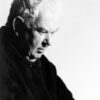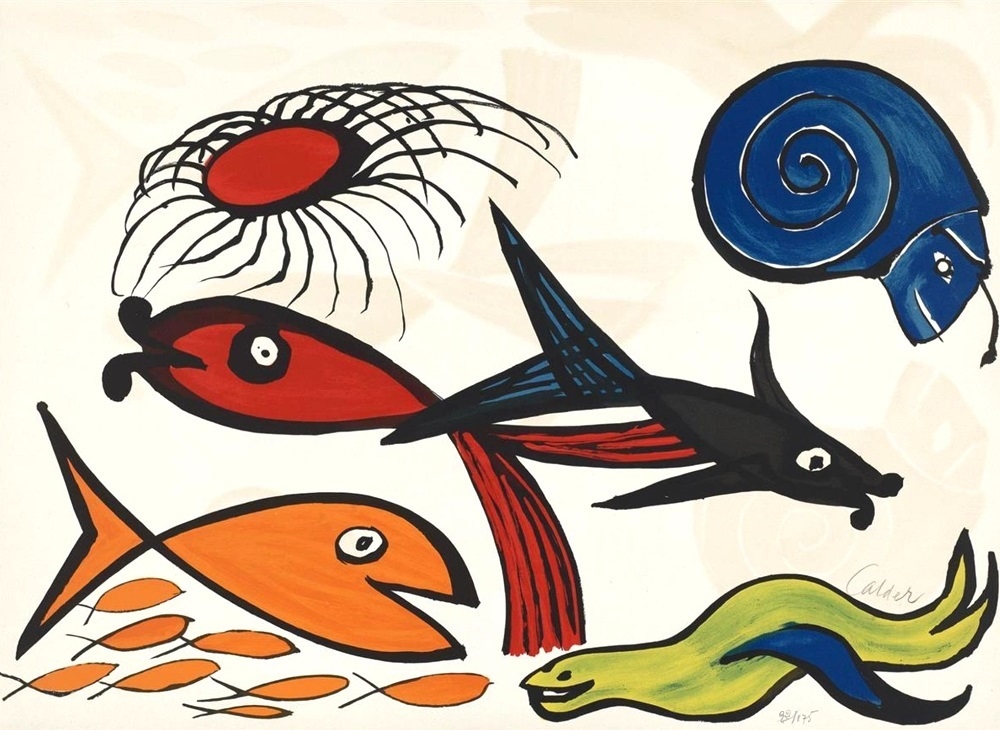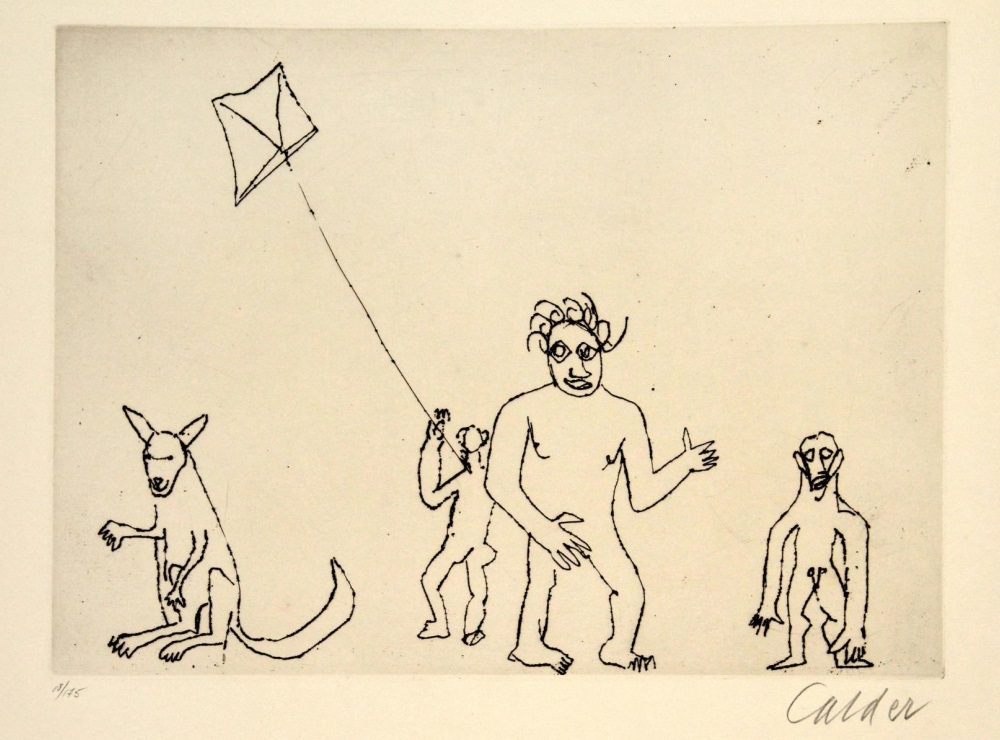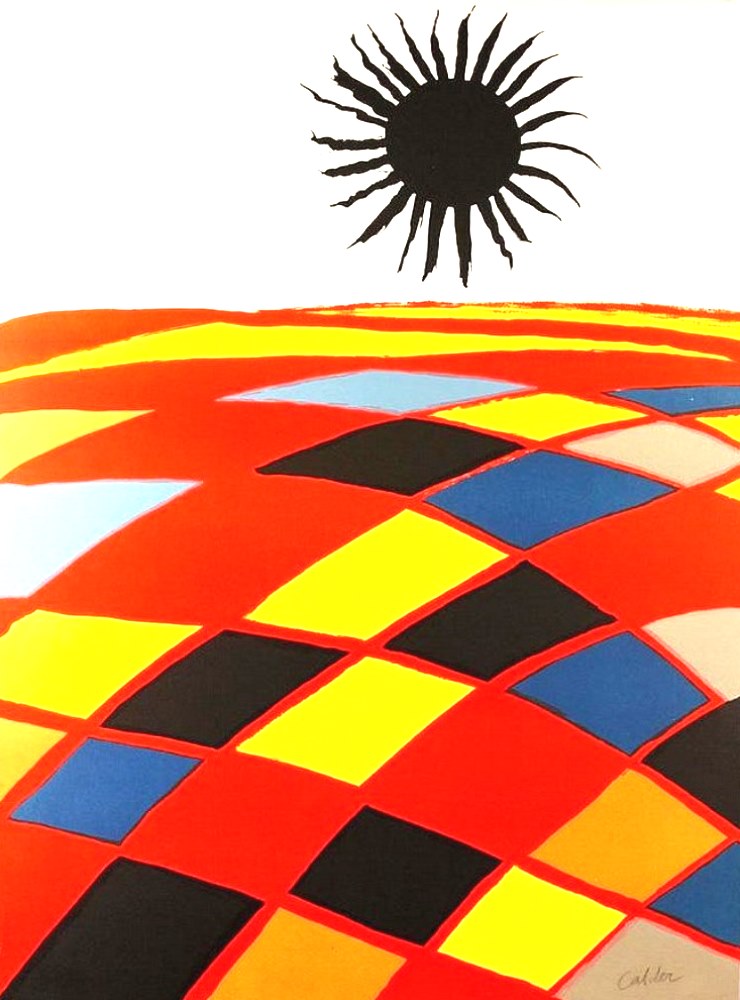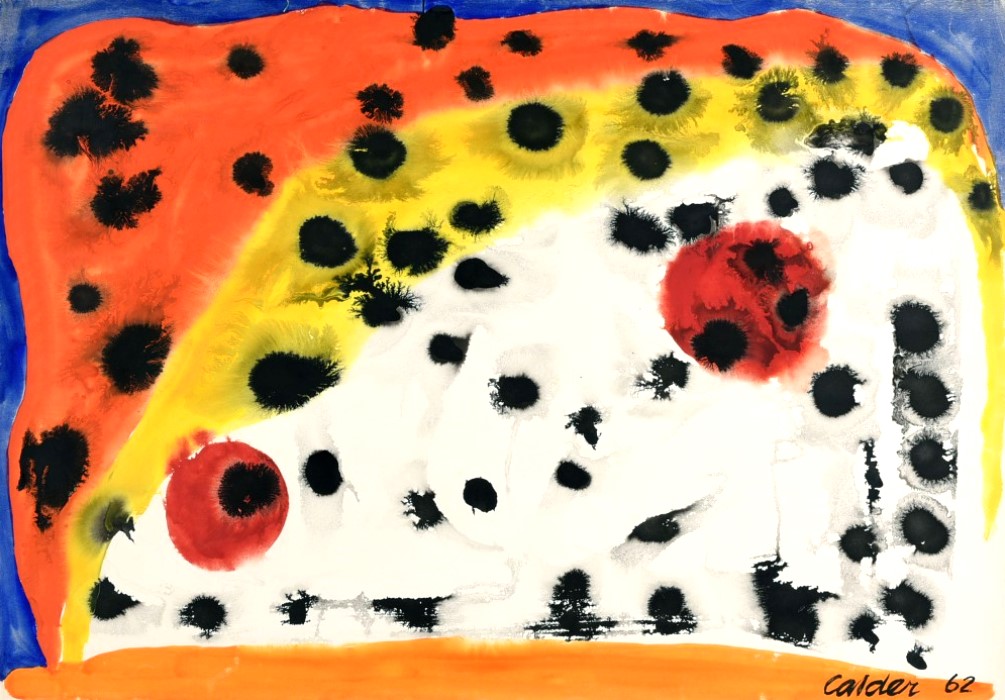Alexander Calder was born on August 22, 1898 and died on November 11, 1976. He was an American sculptor known as the originator of the mobile, a type of kinetic sculpture made with delicately balanced or suspended components which move in response to motor power or air currents. Calder’s stationary sculptures are called stabiles. He also produced numerous wire figures, notably for a miniature circus.
Alexander “Sandy” Calder was born in Lawnton, Pennsylvania on August 22, 1898. His father, Stirling Calder, was a well-known sculptor who created many public installations, a majority of them in nearby Philadelphia.
Sandy Calder’s grandfather, sculptor Alexander Milne Calder, was born in Scotland, immigrated to Philadelphia in 1868, and is best known for the colossal statue of William Penn on top of Philadelphia City Hall’s tower. Sandy Calder’s mother, Nanette Lederer, was a professional portrait artist, who had studied at the Académie Julian and the Sorbonne in Paris from around 1888 until 1893. She moved to Philadelphia where she met Stirling Calder while studying at the Pennsylvania Academy of the Fine Arts. Sandy Calder’s parents married on February 22, 1895; his sister, Mrs. Margaret Calder Hayes, is considered instrumental in the development of the UC Berkeley Art Museum.
In 1902, Sandy Calder posed nude for his father’s sculpture The Man Cub, which is now located in the Metropolitan Museum of Art in New York City. That same year he also completed his earliest sculpture, a clay elephant. Three years later, Stirling Calder contracted tuberculosis, and Calder’s parents moved to a ranch in Oracle, Arizona, leaving the children in the care of family friends for a year. The children were reunited with their parents in late March 1906 and stayed at the ranch in Arizona until fall of the same year.
After Arizona, the Calder family moved to Pasadena, California. The windowed cellar of the family home became Calder’s first studio and he received his first set of tools. He used scraps of copper wire that he found in the streets to make jewelry and beads for his sister’s dolls. On January 1, 1907, Nanette Calder took her son to the Tournament of Roses Parade in Pasadena, where he observed a four-horse-chariot race. This style of event later became the finale of Calder’s wire circus shows.
Thomas Wolfe mocks the performances in his novel You Can’t Go Home Again, in which Calder appears as a character named “Piggy Logan.”
In the fall of 1909, the Calder family moved back to Philadelphia, where Sandy briefly attended Germantown Academy, then moved to Croton-on-Hudson, New York.
That Christmas, he sculpted a dog and a duck out of sheet brass as gifts for his parents. The sculptures were three-dimensional and the duck was kinetic because it rocked when gently tapped. In Croton, during his early high school years, Calder was befriended by painter Everett Shinn with whom he built a gravity powered system of mechanical trains. Calder described it, “We ran the train on wooden rails held by spikes; a chunk of iron racing down the incline speeded [sic] the cars. We even lit up some cars with candle lights”. After Croton, the Calders moved to Spuyten Duyvil to be closer to the Tenth Street Studio Building in New York City, where Stirling Calder rented a studio. While living in Spuyten Duyvil, Sandy Calder attended high school in nearby Yonkers. In 1912, Stirling Calder was appointed acting chief of the Department of Sculpture of the Panama–Pacific International Exposition in San Francisco, California, and began work on sculptures for the exposition that was held in 1915.
During Sandy Calder’s high school years (1912–1915), the family moved back and forth between New York and California. In each new location, Calder’s parents reserved cellar space as a studio for their son. Toward the end of this period, Calder stayed with friends in California while his parents moved back to New York, so that he could graduate from Lowell High School in San Francisco. Calder graduated with the class of 1915.
In 1915, Calder decided to study mechanical engineering, and enrolled at the Stevens Institute of Technology in Hoboken, New Jersey. When asked why he decided to study mechanical engineering instead of art Calder said, “I wanted to be an engineer because some guy I rather liked was a mechanical engineer, that’s all.” At Stevens, Calder was a member of the Delta Tau Delta fraternity and excelled in mathematics. He was well-liked and the class yearbook contained the following description, “Sandy is evidently always happy, or perhaps up to some joke, for his face is always wrapped up in that same mischievous, juvenile grin. This is certainly the index to the man’s character in this case, for he is one of the best natured fellows there is.”
In the summer of 1916, Calder spent five weeks training at the Plattsburg Civilian Military Training Camp. In 1918, he joined the Student’s Army Training Corps, Naval Section, at Stevens and was made guide of the battalion.
Calder received a degree from Stevens in 1919. For the next several years, he held a variety of engineering jobs, including working as a hydraulic engineer and a draughtsman for the New York Edison Company. In June 1922, Calder found work as a mechanic on the passenger ship H. F. Alexander. While the ship sailed from San Francisco to New York City, Calder worked on deck off the Guatemalan Coast and witnessed both the sun rises and the moon setting on opposite horizons.
He described in his autobiography, “It was early one morning on a calm sea, off Guatemala, when over my couch—a coil of rope—I saw the beginning of a fiery red sunrise on one side and the moon looking like a silver coin on the other.”
The H.F. Alexander docked in San Francisco and Calder traveled up to Aberdeen, Washington, where his sister lived with her husband, Kenneth Hayes. Calder took a job as a timekeeper at a logging camp. The mountain scenery inspired him to write home to request paints and brushes.
Shortly after this, Calder decided to move back to New York to pursue a career as an artist. Calder moved to New York and enrolled at the Art Students’ League, studying briefly with Thomas Hart Benton, George Luks, Kenneth Hayes Miller, and John Sloan. While a student, he worked for the National Police Gazette where, in 1925, one of his assignments was sketching the Ringling Brothers and Barnum and Bailey Circus. Calder became fascinated with the circus, a theme that would reappear in his later work.
In 1926, Calder moved to Paris, visited the Académie de la Grande Chaumière and he established a studio at 22 rue Daguerre in the Montparnasse Quarter. In June 1929, while traveling by boat from Paris to New York, Calder met his future wife, Louisa James (1905-1996), grandniece of author Henry James and philosopher William James. They married in 1931. While in Paris, Calder met and became friends with a number of avant-garde artists, including Joan Miró, Jean Arp, and Marcel Duchamp. Calder and Louisa returned to America in 1933 to settle in a farmhouse they purchased in Roxbury, Connecticut, where they raised a family (first daughter, Sandra born 1935, second daughter, Mary, in 1939). In 1955 Alexander and Louisa Calder travelled around in India for three months, where Calder produced nine sculptures as well as some jewelry.
In 1962, Calder settled into his new workshop Carroi, which was of a futuristic design and overlooked the valley of the Lower Chevrière to Saché in Indre-et-Loire (France). He did not hesitate to offer his gouaches and small mobiles to his friends in the country.
He even donated to the town a Sculpture – mobile ‘’stabile trônant’’ (enthroned stabile), which since 1974 has been situated front of the church: an anti-sculpture free from gravity. Throughout his artistic career, Calder named many of his works in French, regardless of where they were destined for eventual display.
In 1966, Calder published his Autobiography with Pictures with the help of his son-in-law, Jean Davidson.
Calder died unexpectedly on November 11, 1976, shortly after opening a major retrospective show at the Whitney Museum in New York.
Source Wikipedia
#biography
